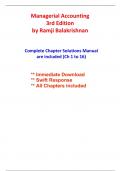Managerial Accounting
3rd Edition
by Ramji Balakrishnan
Complete Chapter Solutions Manual
are included (Ch 1 to 16)
** Immediate Download
** Swift Response
** All Chapters included
, CHAPTER 1
Accounting: Information for Decision Making
Solutions
REVIEW QUESTIONS
1.1 Step 1: Specify the decision problem, including the decision maker’s goals.
Step 2: Identify options.
Step 3: Measure benefits (advantages) and costs (disadvantages) to determine the value
(benefits reaped less costs incurred) of each option.
Step 4: Make the decision, choosing the option with the highest value.
1.2 Because people place different emphasis on factors such as money, risk, and leisure.
1.3 The benefits of an option less its costs. Because value is the contribution of an option to the
decision maker’s goals, we measure value relative to the status quo, which is not doing
anything at all.
1.4 The value of the next best option.
1.5 An organization is a group of individuals engaged in a collectively beneficial mission. The
key difference between individual and organizational decision making relates to goals –
organizational goals rarely coincide with the goals of all individual participants.
1.6 (1) Policies and procedures; (2) Monitoring; (3) Incentive schemes and performance
evaluation.
1.7 Planning decisions relate to choices about acquiring and using resources to deliver products
and services to customers. Control decisions relate to motivating, monitoring, and
evaluating performance.
1.8 Plan, Implement, Evaluate, Revise (PIER Cycle).
1.9 To help measure the costs and benefits of decision options.
1.10 Persons outside the firm. These individuals make decisions about buying and selling stock,
lending money, dividends, and taxes.
1.11 Persons inside the firm. These individuals make decisions about which products and
services to offer, the prices of products and services, what equipment to purchase, who to
hire and how to pay them.
Balakrishnan, Sivaramakrishnan, & Sprinkle – 3e FOR INSTRUCTOR USE ONLY
, 1-2
1.12 The primary users (external vs. internal), governing principles, the unit of analysis,
emphasis, periodicity, and types of data considered.
1.13 Ethics relate to every step of the decision framework. Ethics can shape our goals, the
options we consider, how we measure costs and benefits, and the ultimate decision we
make.
1.14 The Foreign Corrupt Practices Act of 1977.
1.15 The key financial players include the CEO, CFO, controller, treasurer, and chief internal
auditor. The roles of each player are described in detail in the appendix.
1.16 (1) Competence, (2) Confidentiality, (3) Integrity, and (4) Credibility.
DISCUSSION QUESTIONS
1.17 Your ultimate goal could be to earn as much as you can before you retire, say, 40 years
after you graduate. With this goal in mind, you have to plan a career path and evaluate the
three job offers to see which of these jobs will take you on that path. Besides pay, factors
such as the reputation of the organization, the quality of on-the-job training you will get,
opportunities to climb the organizational ladder are very important from a career
perspective. If all three job offers are equally attractive in terms of the career you have
chosen for yourself, then short-term goals and desires will dictate which job offer you
should accept. All else equal, you will naturally want to accept the job offer that pays you
the most, or you may be willing to accept slightly lower pay to live in a city that you like,
or work for an organization with better reputation, and so on.
1.18 Yes, this statement is true. Opportunity cost is the value of the next best option. As more
options become available, it is possible that a new option may be more attractive than the
current best option, in which case the new option becomes the best option, and the current
best option becomes the next best option. In this case, the opportunity cost increases but it
can never decrease as long as all the current options are also available to choose from.
1.19 Let us assume that you are not fully prepared for your exam tomorrow (if you are fully
prepared, then you might as well watch TV because you stand to lose nothing i.e., your
opportunity cost is zero). By watching TV, you risk being unable to answer some questions
and making a poorer grade in the exam. Thus, the opportunity cost is the lost benefit from
not receiving a better grade that the preparation would have helped you secure.
1.20 Let us say that the full-time MBA program takes two years to complete. The opportunity
cost of pursuing the program is the income she will be losing over this period by quitting
her existing job, the experience she will lose from not being on the job for two years, and
any promotions she may be foregoing.
Balakrishnan, Sivaramakrishnan, & Sprinkle – 3e FOR INSTRUCTOR USE ONLY




